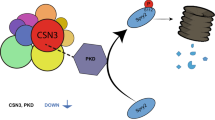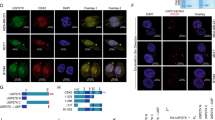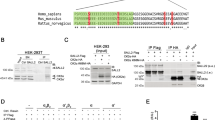Abstract
Protein kinase CK2 is a protein serine/threonine kinase that exhibits elevated expression in a number of cancers and displays oncogenic activity in mice. The regulatory CK2β subunit has a central role in assembly of functional tetrameric CK2 complexes where it participates in modulation of catalytic activity and substrate specificity. Since overexpression of CK2β results in elevated levels of CK2 activity, we investigated the molecular mechanisms that control its degradation since perturbations in these pathways could contribute to elevated CK2 in cancer. In this study, we demonstrate that CK2β is degraded by a proteasome-dependent pathway and that it is ubiquitinated. We have also investigated the role of phosphorylation and a putative destruction box in regulating its stability in cells. Importantly, replacement of three serine residues within the autophosphorylation site of CK2β with glutamic acid residues resulted in a significant decrease in its degradation indicating that autophosphorylation is involved in regulating its stability. Notably, although the autophosphorylation site of CK2β is remarkably conserved between species, this is the first functional role ascribed to this site. Furthermore, based on these results, we speculate that alterations in the phosphorylation or dephosphorylation of the regulatory CK2β subunit could underlie the elevated expression of CK2 that is observed in cancer cells.
This is a preview of subscription content, access via your institution
Access options
Subscribe to this journal
Receive 50 print issues and online access
$259.00 per year
only $5.18 per issue
Buy this article
- Purchase on Springer Link
- Instant access to full article PDF
Prices may be subject to local taxes which are calculated during checkout







Similar content being viewed by others
References
Ackerman P, Glover CV, Osheroff N . 1990 Proc. Natl. Acad. Sci. USA 87: 821–825
Allende JE, Allende CC . 1995 FASEB J. 9: 313–323
Bodenbach L, Fauss J, Robitzki A, Krehan A, Lorenz P, Lozeman FJ, Pyerin W . 1994 Eur. J. Biochem. 220: 263–273
Boldyreff B, Issinger OG . 1997 FEBS Lett. 403: 197–199
Bosc DG, Lüscher B, Litchfield DW . 1999 Mol. Cell. Biochem. 191: 213–222
Bosc DG, Graham KC, Saulnier RB, Zhang C, Prober D, Gietz RD, Litchfield DW . 2000 J. Biol. Chem. 275: 14295–14306
Canton DA, Zhang C, Litchfield DW . 2001 Biochem. J. 358: 87–94
Castro A, Peter M, Magnaghi-Jaulin L, Vigneron S, Galas S, Lorca T, Labbe JC . 2001 Mol. Biol. Cell. 12: 2660–2671
Chen M, Li D, Krebs EG, Cooper J . 1997 Mol. Cell. Biol. 17: 1904–1912
Chen M, Cooper JA . 1997 Proc. Natl. Acad. Sci. USA 94: 9136–9140
Daya-Makin M, Sanghera JS, Mogentale T, Lipp M, Parchomchuk J, Hogg J, Pelech S . 1994 Cancer Res. 54: 2262–2268
de Hoog CL, Koehler JA, Goldstein MD, Taylor P, Figeys D, Moran MF . 2001 Mol. Cell. Biol. 21: 2107–2117
Desagher S, Osen-Sand A, Montessuit S, Magnenat E, Vilbois F, Hochmann A, Journot L, Antonsson B, Martinou JC . 2001 Mol. Cell. 8: 601–611
Dick LR, Cruikshank AA, Destree AT, Grenier L, McCormack TA, Melandri FD, Nunes SL, Palombella VJ, Parent LA, Plamondon L, Stein RL . 1997 J. Biol. Chem. 272: 182–188
Diehl JA, Cheng M, Roussel MF, Sherr CJ . 1998 Genes Dev. 12: 3499–3511
Faust M, Montenarh M . 2000 Cell Tissue Res. 301: 329–340
Faust RA, Gapany M, Tristani P, Davis A, Adams GL, Ahmed K . 1996 Cancer Lett. 101: 31–35
Filhol O, Baudier J, Delphin C, Loue-Mackenbach P, Chambaz EM, Cochet C . 1992 J. Biol. Chem. 267: 20577–20583
Ford HL, Landesman-Bollag E, Dacwag CS, Stukenberg PT, Pardee AB, Seldin DC . 2000 J. Biol. Chem. 275: 22245–22254
Fraser AG, Kamath RS, Zipperlen P, Martinez-Campos M, Sohrmann M, Ahringer J . 2000 Nature 408: 325–330
Gerber DA, Souquere-Besse S, Puvion F, Dubois MF, Bensaude O, Cochet C . 2000 J. Biol. Chem. 275: 23919–23926
Ghavidel A, Schultz MC . 2001 Cell 106: 575–584
Glotzer M, Murray AW, Kirschner MW . 1991 Nature 349: 132–138
Glover III CV . 1998 Prog. Nucleic Acids Res. Mol. Biol. 59: 95–133
Graham KC, Litchfield DW . 2000 J. Biol. Chem. 275: 5003–5010
Guerra B, Issinger O-G . 1999 Electrophoresis 20: 391–408
Hanks SK, Hunter T . 1995 FASEB J. 8: 576–596
Hanna DE, Rethinaswamy A, Glover CVC . 1995 J. Biol. Chem. 270: 25905–25914
Hershko A, Ciechanover A . 1998 Annu. Rev. Biochem. 67: 425–479
Keller DM, Zeng X, Wang Y, Zhang QH, Kapoor M, Shu H, Goodman R, Lozano G, Zhao Y, Lu H . 2001 Mol. Cell. 7: 283–292
Kelliher MA, Seldin DC, Leder P . 1996 EMBO J. 15: 5160–5166
Kikkawa U, Mann SK, Firtel RA, Hunter T . 1992 Mol. Cell. Biol. 12: 5711–5723
King RW, Glotzer M, Kirschner MW . 1996 Mol. Biol. Cell. 7: 1343–1357
Koepp DM, Schaefer LK, Ye X, Keyomarsi K, Chu C, Harper JW, Elledge SJ . 2001 Science 294: 173–177
Krek W, Maridor G, Nigg EA . 1992 J. Cell Biol. 116: 43–55
Krippner-Heidenreich A, Talanian RV, Sekul R, Kraft R, Thole H, Ottleben H, Lüscher B . 2001 Biochem. J. 358: 705–715
Landesman-Bollag E, Channavajhala PL, Cardiff RD, Seldin DC . 1998 Oncogene 16: 2965–2974
Landesman-Bollag E, Romieu-Mourez R, Song DH, Sonenshein GE, Cardiff RD, Seldin DC . 2001 Oncogene 20: 3247–3257
Li D, Dobrowolska G, Aicher LD, Chen M, Wright JH, Drueckes P, Dunphy EL, Munar ES, Krebs EG . 1999 J. Biol. Chem. 274: 32988–32996
Lin WJ, Sheu GT, Traugh JA . 1994 Biochemistry 33: 6998–7004
Litchfield DW, Lozeman FJ, Cicirelli MF, Harrylock M, Ericsson LH, Piening CJ, Krebs EG . 1991 J. Biol. Chem. 266: 20380–20389
Litchfield DW, Lüscher B, Lozeman FJ, Eisenman RN, Krebs EG . 1992 J. Biol. Chem. 267: 13943–13951
Litchfield DW, Lüscher B . 1993 Mol. Cell. Biochem. 127–128: 187–200
Lorenz P, Pepperkok R, Ansorge W, Pyerin W . 1993 J. Biol. Chem. 268: 2733–2739
Lüscher B, Litchfield DW . 1994 Eur. J. Biochem. 220: 521–526
Maki CG, Howley PM . 1997 Mol. Cell. Biol. 17: 355–363
Meek DW, Simon S, Kikkawa U, Eckhart W . 1990 EMBO J. 9: 3253–3260
Moberg KH, Bell DW, Wahrer DC, Haber DA, Hariharan IK . 2001 Nature 413: 311–316
Musti AM, Treier M, Bohmann D . 1997 Science 275: 400–402
Niefind K, Guerra B, Ermakowa I, Issinger OG . 2001 EMBO J. 20: 5320–5331
ole-Moi Yoi OK, Brown WC, Iams KP, Nayar A, Tsukamoto T, Macklin MD . 1993 EMBO J. 12: 1621–1631
Orlandini M, Semplici F, Ferruzzi R, Meggio F, Pinna L, Oliviero S . 1998 J. Biol. Chem. 273: 21291–21297
Penner CG, Wang Z, Litchfield DW . 1997 J. Cell Biochem. 64: 525–537
Pepperkok R, Lorenz P, Jakobi R, Ansorge W, Pyerin W . 1991 Exp. Cell Res. 197: 245–253
Pham CD, Vuyyuru VB, Yang Y, Bai W, Singh B . 1999 Oncogene 18: 4287–4294
Pinna L, Meggio F . 1997 Prog. Cell Cycle Res. 3: 77–97
Prowald A, Schuster N, Montenarh M . 1997 FEBS Lett. 408: 99–104
Rethinaswamy A, Birnbaum MJ, Glover CV . 1998 J. Biol. Chem. 273: 5869–5877
Rifkin IR, Channavajhala PL, Kiefer HL, Carmack AJ, Landesman-Bollag E, Beaudette BC, Jersky B, Salant DJ, Ju ST, Marshak-Rothstein A, Seldin DC . 1998 J. Immunol. 161: 5164–5170
Sayed M, Kim SO, Salh BS, Issinger OG, Pelech SL . 2000 J. Biol. Chem. 275: 16569–16573
Sayed M, Pelech S, Wong C, Marotta A, Salh B . 2001 Oncogene 20: 6994–7005
Schwab M, Tyers M . 2001 Nature 413: 268–269
Seldin DC, Leder P . 1995 Science 267: 894–897
Shi X, Potvin B, Huang T, Hilgard P, Spray DC, Suadicani SO, Wolkoff AW, Stanley P, Stockert RJ . 2001 J. Biol. Chem. 276: 2075–2082
Song DH, Sussman DJ, Seldin DC . 2000 J. Biol. Chem. 275: 23790–23797
Stalter G, Siemer S, Becht E, Ziegler M, Remberger K, Issinger OG . 1994 Biochem. Biophys. Res. Commun. 202: 141–147
Strohmaier H, Spruck CH, Kaiser P, Won KA, Sangfelt O, Reed SI . 2001 Nature 413: 316–322
Teitz T, Eli D, Penner M, Bakhanashvili M, Naiman T, Timme TL, Wood CM, Moses RE, Canaani D . 1990 Mutat. Res. 236: 85–97
Toczyski DP, Galgoczy DJ, Hartwell LH . 1997 Cell 90: 1097–1106
Treier M, Staszewski LM, Bohmann D . 1994 Cell 78: 787–798
Vilk G, Saulnier RB, St Pierre R, Litchfield DW . 1999 J. Biol. Chem. 274: 14406–14414
Vilk G, Derksen DR, Litchfield DW . 2002 J. Cell Biochem. 84: 84–99
Winston JT, Chu C, Harper JW . 1999 Genes Dev. 13: 2751–7275
Yenice S, Davis AT, Goueli SA, Akdas A, Limas C, Ahmed K . 1994 Prostate 24: 11–16
Yew PR . 2001 J. Cell Physiol. 187: 1–10
Yu IJ, Spector DL, Bae YS, Marshak DR . 1991 J. Cell Biol. 114: 1217–1232
Acknowledgements
We are grateful to Kevin Graham and Rebecca St. Pierre for plasmid construction and optimization of procedures required for the ubiquitination assays. We are also grateful to Drs Chris Brandl and Eric Ball for helpful discussion, to Drs Daniela Rotin (Toronto, Canada) and Dirk Bohmann (Heidelberg, Germany) for providing plasmids and to Dr Lina Dagnino for supplying anti-β-tubulin antibodies. The 9E10 monoclonal antibody developed by JM Bishop was obtained from the Developmental Studies Hybridoma Bank developed under the auspices of the NICHD and maintained by The University of Iowa, Department of Biological Sciences, Iowa City, IA 52242. This work was supported by the National Cancer Institute of Canada with funds from the Canadian Cancer Society and from the Canadian Institutes of Health Research (to DW Litchfield). Cunjie Zhang was supported in part by the Premier's Research Excellence Award program (Ontario, Canada). Greg Vilk is the recipient of a Studentship from the National Cancer Institute of Canada and David Canton is supported by a Scholarship from the Natural Sciences and Engineering Research Council of Canada.
Author information
Authors and Affiliations
Corresponding author
Rights and permissions
About this article
Cite this article
Zhang, C., Vilk, G., Canton, D. et al. Phosphorylation regulates the stability of the regulatory CK2β subunit. Oncogene 21, 3754–3764 (2002). https://doi.org/10.1038/sj.onc.1205467
Received:
Revised:
Accepted:
Published:
Issue Date:
DOI: https://doi.org/10.1038/sj.onc.1205467
Keywords
This article is cited by
-
Protein kinase CK2 – diverse roles in cancer cell biology and therapeutic promise
Molecular and Cellular Biochemistry (2023)
-
CIGB-300 anticancer peptide regulates the protein kinase CK2-dependent phosphoproteome
Molecular and Cellular Biochemistry (2020)
-
Developmental and growth defects in mice with combined deficiency of CK2 catalytic genes
Molecular and Cellular Biochemistry (2011)
-
Enhancing chemosensitivity to gemcitabine via RNA interference targeting the catalytic subunits of protein kinase CK2 in human pancreatic cancer cells
BMC Cancer (2010)
-
Over-Expression of Phospholipase D Isozymes Down-Regulates Protein Kinase CKII Activity via Proteasome-Dependent CKIIβ Degradation in NIH3T3 Cells
Molecules and Cells (2009)



